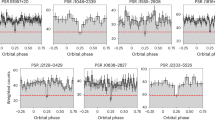Abstract
The recent discovery of two new binary pulsars, PS R1831–00 (ref. 1) and PSR1855 + 09 (ref. 2), brings the total number of these objects to seven. By observations of pulse arrival time one can determine the mass function and al sin i, the projected orbital separation of the pulsar from the system's centre of gravity. By adopting a mass for the pulsar the mass of the secondary can be calculated as a function of the unknown orbital inclination angle i. Here I show that one can make use of the fact that four of these binary systems appear to fit neatly into the evolutionary scheme for bright X-ray sources described by Webbink et al.3. This implies that one can apply another constraint to the orbital solution, namely that the (sub)giant progenitor of the present white dwarf secondary should have filled its Roche lobe while spinning up the pulsar companion by mass transfer. With this extra constraint one can determine the mass of the present white dwarf in these systems4,5,6. It also allows one to set an upper limit of ∼ 1.2 M⨀ to the mass of the neutron star PSR1855+09.
This is a preview of subscription content, access via your institution
Access options
Subscribe to this journal
Receive 51 print issues and online access
$199.00 per year
only $3.90 per issue
Buy this article
- Purchase on Springer Link
- Instant access to full article PDF
Prices may be subject to local taxes which are calculated during checkout
Similar content being viewed by others
References
Dewey, R. J., Maguire, C. M., Rawley, L. A., Stokes, G. H. & Taylor, J. H. Nature 322, 712–714 (1986).
Segelstein, D. J., Rawley, L. A., Stinebring, D. R., Fruchter, A. S. & Taylor, J. H. Nature 322, 714–717 (1986).
Webbink, R. F., Rappaport, S. & Savonije, G. J. Astrophys. J. 270, 678–693 (1983).
Savonije, G. J. Nature 304, 422–423 (1983).
Paczynski, B. Nature 304, 421–422 (1983).
Joss, P. C., Rappaport, S. A. & Lewis, W. Astrophys. J. (in the press).
van den Heuvel, E. P. J. in Proc. IAU Symp 125, Nanking 1986 (eds Helfand, D. J. & Huang, J. H.) (Reidel, Dordrecht, in the press).
Joss, P. C. & Rappaport, S. A. Nature 304, 419–421 (1983).
de Kool, M., van den Heuvel, E. P. J. & Rappaport, S. A. Astr. Astrophys. 164, 73–76 (1986).
Savonije, G. J. & Papaloizou, J. C. B. in Interacting Binaries (eds Eggleton, P. P. & Pringle, J. E.) 83–102 (Reidel, Dordrecht, 1985).
Paczynski, B. A. Rev. Astr. Astrophys. 9, 183–208 (1971).
Davidson, K. & Ostriker, J. P. Astrophys. J. 179, 585–598 (1973).
Kulkarni, S. R. Astrophys. J. 306, L85–L89 (1986).
Author information
Authors and Affiliations
Rights and permissions
About this article
Cite this article
Savonije, G. A determination of the white-dwarf masses in wide binary radio-pulsar systems. Nature 325, 416–418 (1987). https://doi.org/10.1038/325416a0
Received:
Accepted:
Issue Date:
DOI: https://doi.org/10.1038/325416a0
This article is cited by
Comments
By submitting a comment you agree to abide by our Terms and Community Guidelines. If you find something abusive or that does not comply with our terms or guidelines please flag it as inappropriate.



